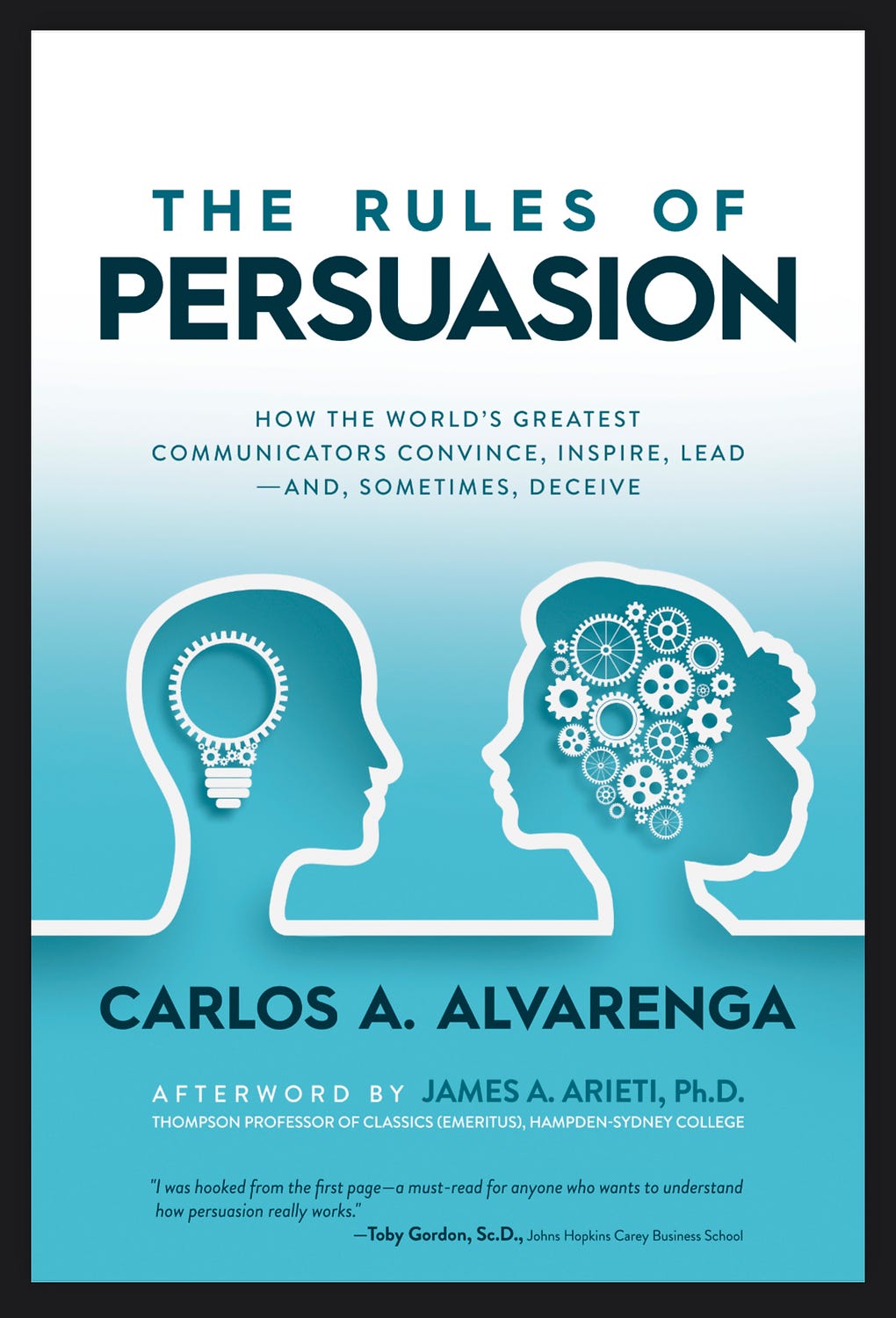"The Rules of Persuasion" Is Here
My new book on what persuasion is and how it works in all forms of human communication is now available.
Author’s note: I am happy to announce that my new book, The Rules of Persuasion, was published by Post Hill Press today. It is now available for purchase on Amazon. Below is the introduction to the book. Cheers, Carlos
Show not what has been done, but what can be. How beautiful the world would be if there were a procedure for moving through labyrinths.
—Umberto Eco, The Name of the Rose
-
In a memorable scene from Kevin Macdonald’s 2006 film, The Last King of Scotland, the Ugandan dictator Idi Amin explodes in anger at his personal physician, Nicholas Garrigan, for allowing him to expel all the Asian nationals from the country. A hysterical Amin chastises Garrigan for not telling him to leave the Asians in peace. The terrified Garrigan defends himself by reminding Amin about the emphatic warning Garrigan had given that the expulsion would bring dire consequences and that the international press would condemn Amin mercilessly. “Yes,” says Amin, you told me all of these things, “but you did not persuade me, Nicholas. You did not persuade me.”
I begin with the scene above because it neatly encapsulates the problem this book examines: Why is it that human communication, which is almost exclusively aimed at persuasion, so often fails to persuade? How is it that very senior leaders, accomplished and successful in so many ways, struggle when asked to convince their boards or employees to follow them or embrace their ideas? On an everyday level, why is it that so many people fail to persuade colleagues, children, and friends when debating important issues or seeking support for a cause? Lastly, how is it that a corrupt communicator can persuade an entire nation to commit acts of savagery or injustice?
Together, we shall look at persuasion through what are at the same time very old and very new perspectives. The basic rules I will explain were first articulated by the philosopher Aristotle over two thousand years ago in a work called Rhetoric. This book, by one of the foremost thinkers the Western world has ever known, is a guide to how language and persuasion work. Contained within it is a simple claim with profound implications.
Persuasion, Aristotle believed, works through three specific modes: character, argument, and emotion. For centuries, Aristotle’s words inspired analysis, inquiry, and debate and were a key part of all for- mal education across the Western world. In the second half of the twentieth century, however, the study of rhetoric disappeared from most primary and secondary education and became an esoteric topic for specialists in classics, philosophy, and logic. There are pedagogical and historical reasons for this disappearance, and I will discuss them in my chapter on the dark side of persuasion. As we shall see, though, Aristotle’s fundamental insights about the three essential elements of persuasion are as true today as they were over two thousand years ago.
Let this book be your guide into Aristotle’s discoveries, updated for our time. It is not meant solely for an academic audience. Unlike many other books on the subject, I will not talk about the esoteric terms of rhetoric that are of little interest to specialists, much less to general readers. I do not think a person needs to know what asyndeton and metonymy are to understand persuasion, or that there were five elements to classical oratory.1 Instead, we will look at how persuasion works all around us through the various means of communication that make up our world.
This book is for anyone who wants to understand what persuasion is, how it functions, how to put its techniques to work, and how to critique their use in virtually any form of human communication— speeches, presentations, film, literature, social media, music, advertising, and visual art. From Homer to Shakespeare, from Magritte to Rothko, from Mao to Rakim, we will examine insights and concepts, some of them secret and powerful, which will fundamentally alter how we think about persuasion. In the end, my goal is to demonstrate that these insights can help make almost everyone a more thoughtful and persuasive communicator.
So, join me now as we embark upon a journey to discover the secrets of persuasion, the primary goal of human communication.
For the curious, asyndeton is the removal of conjunctions, for example, “I came, I saw, I conquered,” and metonymy is the substitution of one term for another (suggested by the term itself), for example, “I love reading Steinbeck.” The five elements are invention, arrangement, style, memory, and delivery.





